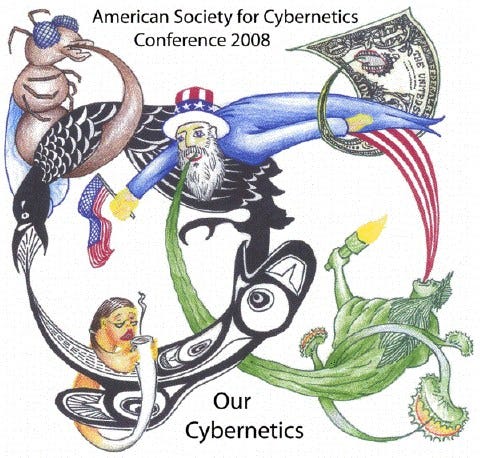The pluralistic roots of the internet and AI
Unraveling the "Why" and "How"
Dear Readers,
Welcome to another edition of the S.A.D newsletter, where we delve into the intricate relationship between our society and Software, Algorithms, and Data from a multidisciplinary perspective.
Before we dive into today’s topic, I’d like to address a choice in the title. Originally, I considered using the term “non-capitalistic roots,” but it felt limiting. Instead, I've opted for “pluralistic” to better capture the complexity without falling into the trap of binary labels.
Whether you identify as non-capitalistic, socialist, capitalist, or market-driven, the past five decades of computing, the internet, and recent advancements in AI have proven that this landscape is far more nuanced than any single label can define. So, let’s start with a question: Is technology inherently capitalist? It’s a rhetorical question, perhaps. Consider this: Is a hammer used by a worker a socialist tool, while computer software used by a stockbroker is inherently capitalist? Or is the answer dependent on how these tools are used?
This query ties into our recent discussions on whether AI can be democratised for the common good or if capitalism has already skewed its potential. Remember, the answers may not be black and white but are likely to reveal the shades.
In my personal contemplation and intellectual exercises, I find the process of arriving at an answer more significant than the answer itself. I’m not particularly interested in knowing if the software I’m currently using is just a cog in the capitalist nightmare (which is probably the case, so is the hammer). Instead, I’m curious about the journey that brought us to this point. This is where the pluralistic perspective becomes crucial. Examining historical accounts, thanks to numerous scholars and meticulous documentation through interviews and research, reveals the complexity in the linear narrative. I will mention two such studies today.
Paying attention to these historical contexts allows us to question things more effectively. While the answers may not be crystal clear, understanding the historical background better equips us for the uncertainties. In essence, emphasising technical innovations without considering the political and economic contexts perpetuates the illusion that technology exists independently of politics. In reality, technology engages in a constant dialogue with its socio-political environment.
Let’s delve a bit deeper into the history of cybernetics and the internet to gain a better understanding of this crucial aspect. While technology is often seen as a neutral tool, it is, in reality, deeply intertwined with political and social forces. Technologies are not just objective outcomes of scientific progress; they embody and reinforce specific values and power structures. Just as organisms require specific conditions to thrive, technologies demand certain social and economic arrangements. The internet has transformed communication, information access, business conduct, relationships, surveillance practices, and monetisation strategies. Some scholars argue that these developments are not inevitable consequences of technological progress; rather, they reflect the political and economic interests of those shaping new technologies.
Approaching this topic through a global-pluralistic lens, let’s examine a specific moment in the history and evolution of cybernetics. Much of the transformation that shaped the internet is commonly linked to cybernetics, discussed in Norbert Wiener's book “Cybernetics, or Control and Communication in Animal and Machine” (1948). Despite being an accomplished scientist, Wiener faced criticism and was branded a pseudo-scientist by the Soviet Union, leading to the characterisation of cybernetics as an “American Pseudo-Science.” Some of these criticisms stemmed more from an anti-American stance rather than an anti-cybernetics perspective:
In 1951, a public campaign in the Soviet Union called the computer hype in the United States a “giant-scale campaign of mass delusion of ordinary people.” The 1951 volume Against the Philosophical Henchmen of American-English Imperialism categorized cybernetics as part of a worrying fashion around “semantic idealism” and dubbed cyberneticists “semanticists-cannibals” for their recursive logics, especially self-informing feedback loops. In addition to American cyberneticist Norbert Wiener, the volume identified those belonging to the group of “semantic obscurantists” as including logician-pacifist Bertrand Russell, his Cambridge colleague Alfred North Whitehead, and Vienna Circle logical positivist Rudolf Carnap. Positivism, semiotics, and mathematical logic all appeared guilty of the cardinal cognitivist belief that “thinking was nothing “thinking was nothing else than operations with signs.” In 1952, Literaturnaya gazeta ran an article called “Cybernetics: A ‘Science’ of Obscurantists,” which cleared the way for a deluge of popular titles: “Cybernetics: An American Pseudo-Science,” “The Science of Modern Slaveholders,” “Cybernetics: A Pseudo-Science of Machines, Animals, Men and Society,” and so on.
This excerpt comes from a 2016 publication by Benjamin Peters titled “How Not to Network a Nation: The Uneasy History of the Soviet Internet.” Peters goes into quite a few details about how Soviet Union tried to build a national network (like the Internet we know) and failed. And the crux he brings in into the narrative is that the reason is not because it was a socialist project, nor they were technologically backwards compared to U.S.A, it was something else. One approach they did have is of course, it was a top down process to create a “command economy”. It was also pushed by the Soviet military (which is also a similar story with DARPA and ARPANET):
As Soviet economic cyberneticists emerged as a viable option in the early 1960s and again early 1970s, they confronted a monumental problem in managing and reforming the command economy. The question was identified by the Austrian school of economics decades earlier: which techniques and approaches would help resolve the mounting tensions among the formal command economy, the gray economy, and the infusion of informal practices in the administration of Soviet socioeconomic life? For the most part, the leading Soviet economic cyberneticists sought to fix the formal command economy by introducing ambitious, even grandiose, plans for automating and modeling the administrative planning decision process itself. And yet, as is shown, those formal plans—a networked plan to fix the planning process itself—did not work because even cybernetic plans could not account for nonlinear operations in the Soviet economy.
One of the big project the book talks about is OGAS (“ОГАС”, “National Automated System for Computation and Information Processing”) ambitious plan to create a nationwide computer network that would automate and optimise the Soviet economy. The network was designed to be a decentralised system that would allow information to be transmitted and modified in real time.
Victor Glushkov was the main brain behind this:
In Glushkov’s design, the network would afford interactive and collective remote access and communication vertically up and down the planning pyramid and horizontally among peer and associated computing centers. Glushkov writes: “the characteristic quality of the network was a distributed database with zero- address access from any point of the system to all the information after automatic verification of the qualified user.” In other words, any user with proper permission could access all the content of the network at any point on the network. At local levels, factory workers would be able to input their own information, reports, and recommendations about improving factory workflow, which would automatically be stored in a national unified database for local, regional, and national review.
Glushkov was influenced by the study of neural networks and envisioned the OGAS project as a “brain-like” network for managing the national economy, based on the then-current understanding of the human nervous system (which was often flawed). However, there are a few nuanced differences in how these systems and concepts emerged:
To reduce it to a simplistic cold war binary: cybernetic network entrepreneurs throughout the world had competing analogs for thinking about national networks. In America, the ARPANET was designed to resemble a brain of the nation because its visionaries first imagined the nation as a single distributed brain of users. In the Soviet Union, the OGAS was designed to resemble a nervous system for the nation because its visionaries first imagined the nation as a single incorporated body of workers. This Soviet analog between network and nervous system, far from determining the outcome of the network, also occurred in Project Cybersyn in the early 1970s in Chile. Its principal architect, the British cyberneticist Stafford Beer, sketched the socialist Salvador Allende’s nation as a viable system that was based on the “human nervous system” analogized with a comprehensive firm or corporate organization—complete with executives in adaptive feedback loops with the national body of workers.
Undoubtedly, the Soviet OGAS Project aimed for an ambitious feat—creating a fully automated system to manage the Soviet economy. Unfortunately, this endeavor failed, leading to the demise of the envisioned Soviet Internet. However, intriguing developments also unfolded in the realm of research and experimentation, mirroring happenings in the U.S.A around the same time.
In the 1960s, a group of young researchers at the Institute of Cybernetics in Kiev embarked on a unique venture: the creation of a virtual country named “Cybertonia.” This playful and informal initiative served as a means for the researchers to foster connections and enjoy themselves, complete with a saxophone-playing robot serving as their mascot. This illustrates a parallel trajectory with local nuances, shaping distinct outcomes in the Soviet cybernetic landscape.
Benjamin Peters concludes that the primary reason behind the failure of the OGAS project wasn’t its centralised, socialist nature, but rather stemmed from issues of self-interest, corruption, and bureaucracy. The Soviet system and culture, outside of the centralised military command, was informal and dynamic, with unpredictable promotions and demotions, occasionally hindering various forms of cooperation and innovation. Peters further argues that the OGAS project aimed at technocratic reform, incorporating elements of both public and private approaches but lacked proper coordination and balance. Despite its intent to regulate and curb “self-interest,” a common aspect in both socialism and capitalism, it failed in execution. State and market actors in the Soviet command economy pursued their private interests, akin to capitalist behaviour.
In contrast, the success of ARPANET can be attributed to cooperation and openness. Despite being hierarchical, the U.S. military facilitated cross-sector knowledge exchange and innovation transfer. This innovation and shared culture driven by the American military-industrial-academic complex also often was motivated by personal interests. Conversely, the Soviet military consumed resources and retained innovations from the civilian economy, contributing to the ultimate failure of the Soviet Internet. In summary, Peters encapsulates the situation by noting that "The [US] capitalists behaved like socialists while the [Soviet] socialists behaved like capitalists."
This is one of the book’s many insightful observations that returns us to the broader discussion of socialism versus capitalism. While the Soviet Union’s OGAS project had a clear vision for a socialist utopia, it lacked the appropriate environment to realise its aspirations. Conversely, the U.S. ARPANET possessed the technical solution (packet-switching networks) but lacked a clear vision for its own utopian potential. How do we bring this in to our current discussion about the internet and AI? This absence of a shared vision has contributed to the internet’s current state, characterised by excessive commercialisation and exploitation, also known as Enshittification. It’s the proper balance of vision and know-how might lead us to somewhere nice:
The Soviet OGAS figured out the “why?” (socialist utopia) but not the “how?” for their large computer network projects, and researchers at the U.S. ARPANET knew the “how?” (packet-switching networks) but not the “why?” of modern networking. The Soviets’ missing “how?” lasted for the duration of the project, and the absence of the Western “why?” remains both its historical attraction and the contemporary challenge to computer network culture.
The Western network “how?” has sped many unfinished attempts at answering the network “why?” The technical openness of packet-switching networks to diverse actors has afforded the Internet astonishing and well-documented successes of technical energy, commercial innovation, and cultural creativity. At the same time, the open-ended “why?” that has permitted such generativity has also tolerated the entrance of private forces that are interested in seizing possession of the operating systems and communication infrastructures that mediate the globe.
I also highly recommend another book called Balkan Cyberia: Cold War Computing, Bulgarian Modernization, and the Information Age Behind the Iron Curtain by Victor Petrov that examines the role of computer technology in Bulgaria during the Cold War era. He argues that the introduction of computers in Bulgaria was not simply an attempt to emulate Western technology, but rather a means of achieving national modernisation and technological independence.
Here’s an excerpt from a Nov 2023, book review:
Bulgaria. It is not the first place many people would think of. In the popular imagination (and in much economics scholarship), Bulgaria is a poster child for rural agrarianism and underdevelopment. Cold War Bulgaria conjures an even more inauspicious image as one of the most stalwart political vassals of the Soviet Union.
But by the 1980s, Bulgaria was one of the world’s major producers of computers. By conservative estimates, one in every 10 industrial workers was employed by the computer industry. The country held a 45 percent market share of electronic exports inside the Eastern Bloc. Its executives rubbed shoulders with Bill Gates and Steve Jobs in 1980s California and sold the PCs powering India’s IT revolution. Its children were taught coding in communist youth groups, attended computer clubs, and swapped comic books depicting cyborg Lenins and a socialist ChatGPT. The country’s factories built pneumatic robot combines that could automate manufacturing, and its manufacturers supplied microprocessors for the state-of-the-art satellite Interkosmos 22 pinging around Earth’s orbit.
How did this happen? And why on earth haven’t we heard about this cyber-land before? The second question is easier to answer. We haven’t heard of it because it collapsed in 1990, and winners don’t like remembering losers. And because Bulgaria is classed as “peripheral.” It is on the margins of every map: Europe, the Cold War, the global economy, the digital revolution. Policymakers and trendsetting gurus don’t tend to look for answers to big issues in these “small” and unfamiliar places (unless doing so involves a happiness index). This is finally changing. Some of the best history books being written today are turning “to the margins” to find previously unrecognized laboratories of modernity.
The author argues that the Bulgarian computer industry operated differently than its Western counterparts. The computer was part of both opening and closing the world available to societies. In the socialist world, it created different intellectual horizons centred on new forms of creativity and seamless production control. The computer also allowed Bulgaria to operate as an agent and participant in globalisation, not just as a recipient of Western technology.
Reflecting on these historical trajectories, it is interesting to consider the alternative paths that might have unfolded if the Soviet, Chilean, or Bulgarian internet initiatives had taken the global stage. While we’ll never know the outcome, we find ourselves now in a present shaped by entities like OpenAI, Elon Musk, and shared societal challenges such as the housing crisis and homelessness in a city like San Francisco, war, and environmental collapse.
The delicate balance between self-interest and collective benefit reflects a broader theme apparent both locally and globally. As mentioned earlier, the Soviet OGAS project aimed to answer the “why?” with aspirations of a socialist utopia but faced challenges with the “how?” Conversely, researchers at the U.S. ARPANET understood the “how?” of modern networking but grappled with the “why?” I remain uncertain if we will ever reach that state of equilibrium. But one can hope, right?






"....without falling into the trap of binary labels..." Would that all political and social discourse adhere to this principle.